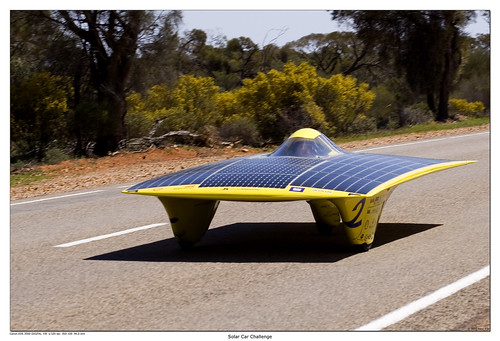There's also a theory floating about that the real source of the gloom about this year's show is that the number of ridiculously expensive over-the-top media shindigs has been curtailed, so the automotive press is sulking a bit about having to cover the event without glomming on to the usual goodies and perqs.
And yet with all that, there's also been quite a bit of discussion of the really large number of new hybrid, fuel cell, electric, and other alternate-fuel vehicles that are there this year, and honestly that's the part that most interests me. Where is this industry going if it manages to survive the next couple of years? I remember very clearly looking at the hybrid offerings a couple of years ago and thinking that it looked obvious to me that the U.S. manufacturers really weren't serious about going in that direction, despite talking a green game.
So, Monique and I headed out into our wintry Sunday very interested to see what was actually going on this year. And it was indeed interesting.
We started down in the basement of Cobo, which is usually the most interesting spot for me because it's where all the really outside-the-mainstream stuff ends up. This year many of the usual basement dwellers got promoted to the main floor because of those larger manufacturers pulling out. So much of the display space was taken up by a large exhibit by the Michigan Economic Development Corp. that let attendees drive actual hybrid and alternative-energy vehicles through a little forest of actual trees and flowers that they had created to give it that "green" touch. Here's a picture of the exhibit that I grabbed off the web:
I thought the idea of this exhibit was particularly interesting, since I don't recall anybody actually driving vehicles at the auto show before. I think the idea was to get people comfortable with the idea of driving something powered by something other than a standard internal-combustion engine. It looked as if the drivers were having a good time.
Much to my surprise Monique told me that this was one of the more controversial exhibits. Not because of anything to do with the alternate-fuel vehicles, but because all of the mulch used for the live plantings was apparently really stinking up Cobo Hall. I didn't think it was all that whiffy, though.
There were a couple of other pretty good exhibits down there. One was a windmill company (mariahpower.com) that produces a nifty-looking windmill called the Windspire. Here's a scenic picture so you can see what it looks like:
It supposedly costs $5,000 minus a 30% tax credit, which I guess means that it really rings up at $3,500, and produces about 2000 kWh per year, which is about enough to run the average house. The lady at the exhibit said it usually pays back its cost in about three years. Interesting stuff. The idea of living "off the grid" and producing our own power has great appeal.
One of the other interesting items in the basement was the University of Michigan solar racing car. Here's a picture of the car at last year's show:
One of the other interesting items in the basement was the University of Michigan solar racing car. Here's a picture of the car at last year's show:

We talked to one of the guys at the exhibit. This car uses the same sort of extremely high-end and very light solar panels that they use on satellites, which meant that it's top is covered with about $250,000 worth of panels. I reckon that means it might be a smidge farther from commercial viability than the Windspire.
Here's a photo of the car in action at the Solar Car Challenge:

I find it enormously cool that a car can run on just solar power. Sure we're not likely to be driving around in solar cars anytime soon. But in the upstairs displays Toyota was showing some sort of solar-powered moonroof option (yeah, I know, kinda oxymoronic when you think about it) for the next generation of the Toyota Prius. So it seems to me that some of this technology is slowly making its way out of the labs and the concept cars and into production.
Next post, on to the main floor! (Where we actually remembered to pull the camera out of the bag, so we have some photos of our own instead of these that I had to Google.)


No comments:
Post a Comment